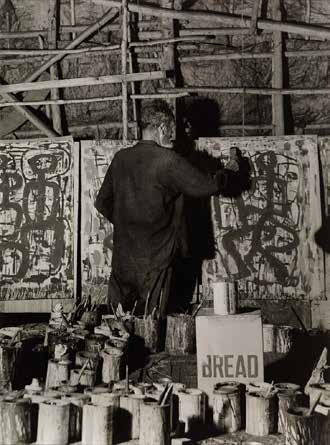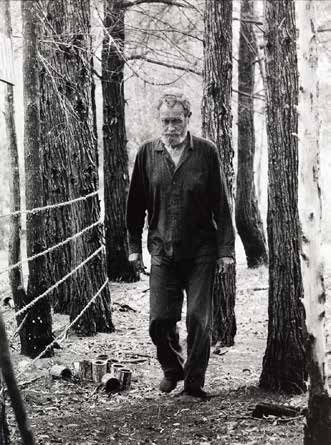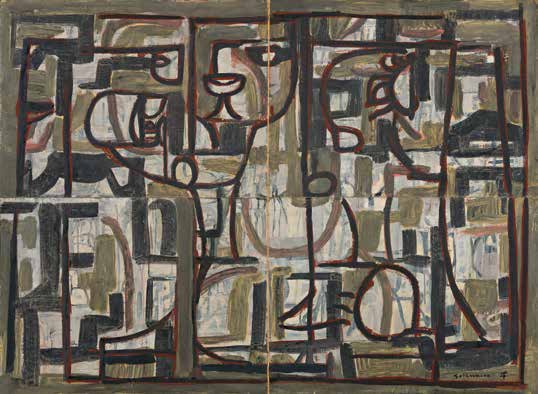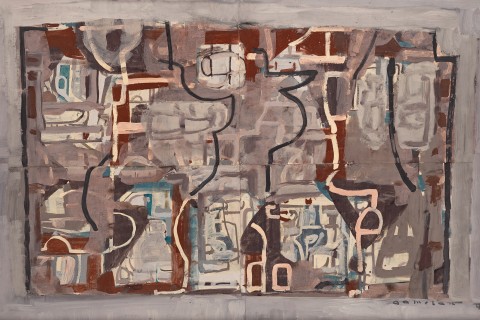GAMELAN, 1958
IAN FAIRWEATHER
synthetic polymer paint and gouache on four sheets of cardboard on hardboard
126.5 x 189.5 cm
signed with artist’s monogram lower right: IF
inscribed with title lower right: Gamelan
bears inscriptions verso: GAMELAN – IAN FAIRWEATHER / FROM MACQUARIE GALLERIES / 19 BLIGH ST, SYDNEY
RESERVED / MRS TURNER / 21/91 MANDALONG RD / MOSMAN
bears inscription on partial label verso: A014 / - GAMELAN - / FAIRWEATHER
Macquarie Galleries, Sydney
John and Jan Altman, Melbourne
Bonython Galleries, Sydney, c.1967
Australian Galleries, Melbourne
Geoff K Gray Auctions, Sydney, 13 February 1974, lot 33
Jack and Beryl Kohane, Melbourne
Niagara Galleries, Melbourne
The Reg Grundy AC OBE and Joy Chambers-Grundy Collection, acquired from the above in 1996
Ian Fairweather, Macquarie Galleries, Sydney, 19 November – 11 December 1958, cat. 2
Festival Exhibition, Royal South Australian Society of Arts, Adelaide, March 1962, cat. 25
Australian Irresistibles 1930 – 1970, Bonython Gallery, Sydney, 11 August – 2 September 1970, cat. 47
Bail, M., Ian Fairweather, Bay Books, Sydney, 1981, pp. 149, 204
Bail, M., Fairweather, Art & Australia Books in association with the Queensland Art Gallery, Brisbane, 1994, ill. 15, pp. 57 (illus.), 58, 61
Bail, M., Fairweather, Murdoch Books, Sydney, 2009, cat. 155, pl. 129, pp. 146 - 47, 150, 151 (illus.), 158, 255
1 fair.jpg

Modern Art, Brisbane
Ian Fairweather has been described as ‘the least parochial of Australian painters, an artist of exceptional force and originality’1 and he is undoubtedly one of the most singular artists to have worked in Australia during the twentieth century. Although he is claimed as an Australian and spent many years living here, he had a restless spirit and the story of his life reads like the pages of an adventure book. Born in Scotland, Fairweather undertook his formal art education at London’s Slade School of Fine Art, studying under the formidable Henry Tonks and in 1922, being awarded second prize for figure drawing. As a prisoner of war in Germany during the First World War he had access to books about Japanese and Chinese art, and later, studied these languages at night. In 1929 he sailed to Shanghai where he lived for several years, the country’s unique art, culture and philosophy exerting a lasting influence on his art. Peripatetic by nature, or perhaps reluctant to establish roots and commit to ongoing relationships, Fairweather travelled extensively – from London, to Canada, China, Bali, Australia, the Philippines, India and beyond – ‘always the outsider, the nostalgic nomad with a dreamlike memory of distant places and experience.’2
Fairweather’s first encounter with Bali was in the early 1930s. Travelling to Australia from China, where he had lived for the past few years, his boat stopped at Buleleng on the northern coast of the island and, after going ashore, he changed his plans and stayed there for almost nine months. It was a happy and productive time during which he painted almost forty known works. Some were Chinese landscapes – painted from notes and recollections of his recent experiences – but the majority depicted Balinese figure subjects, studies of solitary figures or scenes describing local people going about their daily lives.3 In 1933 he painted two mural-sized works which are ambitious both in terms of scale – being among the largest works he ever made – and the complex, multi-figure scenes they depict. Bathing Scene, Bali, c.1933 – 34 was acquired by the Tate Gallery, London in 1935 (Presented by the Contemporary Art Society) and the following year, Leicester Museums and Art Gallery purchased Procession in Bali, 1933, a panoramic scene thought to depict an episode from a traditional marriage ceremony. In a letter to his friend, Jim Ede, Fairweather, who was typically self-critical, wrote, ‘Don’t think too badly of the paintings – they are terribly crude on the surface and were done under trying conditions’, adding, ‘oh hell – Bali was somewhere near to heaven.’4 It was a place that obviously had a profound impact on Fairweather and remembering his experience of Bali decades later, he declared, ‘I was hypnotised and never recovered.’5 A second, much shorter and less pleasant visit to Bali, followed the infamous journey of 1952 when he left Darwin Harbour on a hand-built raft with the aim of sailing to Timor. By way of explanation, he subsequently told an interviewer that Timor ‘(was) the next best thing to Bali where I had done the best painting of my life’.6
2 fair.jpg

Modern Art, Brisbane
Gamelan was painted in 1958, five years after Fairweather had settled on Bribie Island, off the coast of Queensland, and where, for the rest of his life, he famously lived in a pair of huts built with materials salvaged from the surrounding bush. Conditions were primitive – no running water, sewerage or electricity – and Fairweather’s handmade bed and chairs were reportedly upholstered with fern fronds.7 Despite the rudimentary nature of his surrounds however – or perhaps because of it – the next two decades witnessed the production of many of Fairweather’s finest paintings and the 1960s saw his art acknowledged in significant ways, with works being included in the landmark exhibition Recent Australian Painting at the Whitechapel Gallery, London (1961); the European tour of Australian Painting Today (1964 – 65); and in 1965, a major travelling retrospective of his work was mounted by the Queensland Art Gallery.While the title of the painting refers to the traditional Indonesian percussion orchestra which Fairweather presumably witnessed in Bali, Gamelan is not a representational depiction. Murray Bail sees it as a ‘remembrance of… happy times on Bali, which in turn traces more memories, or moods of memories’,8 while composer Martin Armiger identifies a connection between the sound of the gamelan and the construction of the picture. ‘As rhythm builds on rhythm… simple melodies take on subtle variations, the various strands interweave delicately. The relationships between these melodic strands shift… gradually, hypnotically’.9 He continues ‘…patterns emerge from gamelan, as form emerges from… this painting’10, subtly evoking the experience of its subject through gestural line, shape and layering which emphasise the process of art-making, more than the end result.
Alongside Last Supper, 1958 (Art Gallery of New South Wales); Gethsemane, 1958; and Kite Flying, 1958 (both Queensland Art Gallery I Gallery of Modern Art), Gamelan is one of four important large-scale paintings which Fairweather completed in 1958. Variously composed of three or four cardboard sheets joined together, the increased scale of these works signalled a newfound confidence and authority in Fairweather’s approach, the expanded pictorial scope opening up his compositions so that they retain their distinctive linear complexity, but simultaneously assume a new sense of strength and monumentality. The significance of these works was recognised early on by distinguished collectors renowned for their sophisticated
3 fair.jpg

on hardboard
Modern Art, Brisbane
and discerning eyes – author Patrick White purchased Gethsemane from its second exhibition in 1961, and curator and art historian, Daniel Thomas AM, was the first owner of Last Supper, buying it in 1962. Sending the works to Treania Smith at Macquarie Galleries, Sydney in 1958, with detailed instructions for their preparation and mounting, Fairweather wrote, ‘I guess they are really murals – in feeling as well as size – and not at home in living rooms’. He added, ‘They have given me hell – They are an attempt to climb up to something out of something else.’11 The ‘something’ he was seeking was abstraction, and these works are especially significant in that they mark the beginning of a move towards pure abstract imagery which he likened to ‘the Buddhist idea of suspended judgement – The mind is cleared of thought but not of awareness – Always the purpose of art is to find its way through the forest of things to a larger unity containing all things’.12
1. Bail, M., Ian Fairweather, Bay Books, Sydney, 1981, p. 220
2. Bail, M., ‘The Nostalgic Nomad’, Hemisphere, Canberra, vol. 27, no. 1, 1982, p. 54
3. Bail, M., Ian Fairweather, Murdoch Books, Millers Point, 2009, p. 23
4. Ian Fairweather to Jim Ede, late 1933, quoted in quoted in Roberts, C. & Thompson, J. (eds.), Ian Fairweather: A Life in Letters, Text Publishing, Melbourne, 2019, p. 15
5. Ian Fairweather to Treania Bennett, 12 April 1956 in Roberts & Thompson, ibid., p. 387
6. Bail, 2000, op. cit., p. 103
7. Ibid., p. 119
8. Ibid., p. 146
9. Armiger, M., ‘Fairweather and Music’ in Bail, M., et. al., Fairweather, Art & Australia Books in association with Queensland Art Gallery, Brisbane, 1994, p. 58
10. Ibid.
11. Ian Fairweather to Treania Smith, early 1958, Roberts & Thompson, op. cit., p. 218
12. Ian Fairweather to Annette Waters, 23 – 25 October 1958 in Roberts & Thompson, op. cit., p. 226
KIRSTY GRANT
